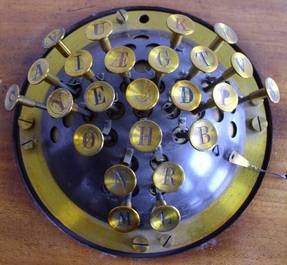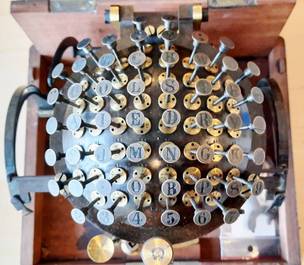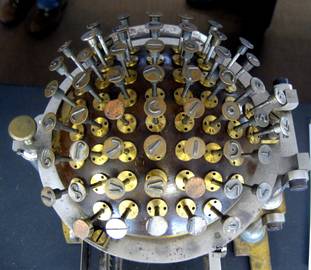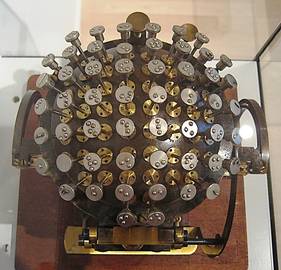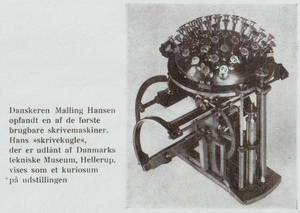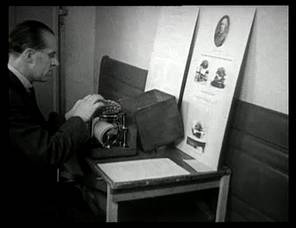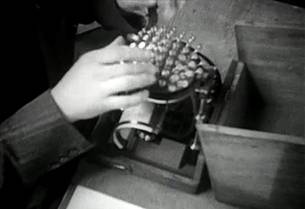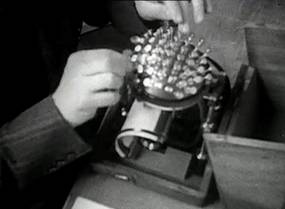The Malling-Hansen writing ball keyboard.
Research and comments by Jørgen Malling Christensen.
Illustrations by Sverre Avnskog.
Recently a hitherto unknown video has come to light, showing in a short clip a man who appears to be typing with considerable speed on an 1878 model writing ball. The clip is part of a short film in black and white, without sound, made in connection with an exhibition of inventions in Copenhagen in November 1937. The video can be found at:
www.danskkulturarv.dk/dr/opfindernes-udstilling-i-1937.
However, closer scrutiny of the video reveals that the person is not typing, because – as Dieter Eberwein points out – the paper platen is not moving. In other words, he is pressing down the keys to some degree but not all the way to the bottom.
In the background we note another interesting item: A poster depicting a portrait of Malling-Hansen and three different models of writing balls. It so happens, that this very poster (or another original of it) presently belongs to our board and founding member, Uwe Breker. He proudly displayed it, when hosting our 4th general assembly of the International Rasmus Malling-Hansen Society, which took place in Cologne on May 27, 2012.
Nevertheless, even if the typing in 1937 is not “the real thing”, this short video clip is still one of the rare instances where we have documentary evidence of a person using a writing ball.
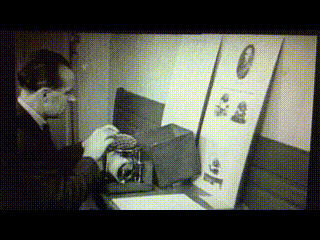
- The actual small movie from 1937 of a man typing on a writing ball.

- Our member, Uwe Breker from Køln, has a large collection of Malling-Hansen items. Among them is a writing ball in a mahogany box, two miniature patent-models, a very rare portrait of RMH, som pictures of RMH's daughter, Zara, and her family and some letters from Zara's son who sold some artefacts to Uwe.
In this article, I would like to briefly explain why the writing ball keyboard was superior to those found in other typewriters of its era.
First of all, we must keep in mind that Malling-Hansen’s goal and purpose – clearly stated in his various patency applications – was always to construct a machine for speed writing, useful for public and private offices, in parliaments, court rooms, universities and schools, - in short, a machine to substitute the slow pen and thus make all kind of writing more efficient. During his time, and frequently repeated later, the misunderstanding was prevailing that his purpose was to use the writing ball as a tool for the blind or the deaf. Although he did construct a few writing balls specifically for blind people, this was not his main target group. The main target group was ordinary people, working in offices and homes.
Consequently, Malling-Hansen spent several years – from 1865 and forward – measuring the speed needed to type as quickly as possible and near the speed of public speeches.
I would like here to quote from our board and founding member, Dieter Eberwein’s presentation at the 7th general meeting in Paderborn on June 2, 2018. Dieter stated that Malling-Hansen showed his genius in the design of the keyboard, spending years in testing, improving and perfecting the placement of the keys. Malling-Hansen carefully studied the percentagewise frequency of the letters of the alphabet and placed the most frequently used letters in the typing spots which corresponded to the fingers most able and nimble in typing.
Dieter showed statistical tables, based om extensive alphabetical research on many different languages. He concluded that most of the European languages possess approximately the same frequency features as the Danish language. Hence, Malling-Hansen’s keyboard arrangement was optimal for many languages.
Dieter has restored several writing balls, the most well-known being Nietzsche’s machine, and in 2005 Dieter published a book about this restauration work.[1]
Adding to Dieter Eberwein, Malling-Hansen’s genius resides in three aspects of the writing ball:
1. The general design of the writing ball
2. The technical precision of its parts
3. The keyboard design
The present article focuses on the advantages of the keyboard design, and adding to Dieter’s expert assessment, I would like to add two ergonomic factors that, to my mind, strengthen the argument for the Malling-Hansen keyboard design.
1) Each model of the writing ball – including the speed-writing machine ‘the tachygraf’ – has a circular keyboard, forming a perfect circle with a surprisingly small diameter. In the case of the 1878 model the diameter was only 117 mm. The compactness of this circle ensures that the typist’s hands always remain in approximately the same position. No time is wasted in moving hands and fingers from side to side.
In contrast, the early Sholes & Glidden typewriters, as well as the Remington Models 1 and 2, featured a broad and flat keyboard, arranged in 4 horizontal rows, spanning ca. 35 cm in width. Hence, the hands and fingers need to move much more from side to side, thus losing precious time.
2) The other aspect of the Malling-Hansen circular arrangement is that visually it is easier and quicker to scan the compact, circular keyboard than the wide and rectangular keyboard of the Remington typewriters of Malling-Hansen’s era – or, for that matter, our modern day computer keyboard, which is spatially around twice as big as the writing ball keyboard.
My present laptop keyboard, e.g., is 34 cm wide and 10 cm vertically. In other words, it covers 340 sq.cm. Comparing with the writing ball keyboard, where the eyes only need to scan across an area of 107,5 sq.cm (with a diameter of 11,7 cm), it is obvious that visually it is quicker and easier to use the Malling-Hansen keyboard.
[1] JMC: “Nietzsche’s Writing Ball”, Typoskript-Verlag, Schauenburg. See also our article ’The Malling-Hansen Writing Ball: Assessing its Quality’, as well as the link to a complete download of Dieter Eberwein’s book.


